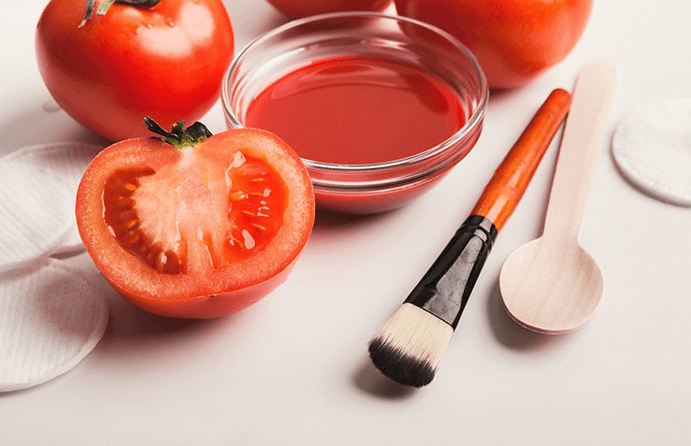In this day and age, we are constantly looking for better ways to enhance our skin’s appearance. One simple ingredient that can provide a variety of skin benefits is the humble tomato. That’s right – the same fruit you toss into your salads and sandwiches can also help improve the health and appearance of your skin. In this article, we’ll dive into the science behind the active ingredients in tomatoes that make them so great for the skin, the benefits they offer, any potential side effects, and even some DIY mask recipes you can try at home.
Research
Tomatoes (
Solanum lycopersicum
) carry an abundance of nutrients and phytochemicals such as lycopene, iron, folate, vitamin C, and potassium. In addition to lycopene and vitamin C, tomatoes carry other antioxidants, such as beta-carotene, and phenolic compounds, including flavonoids, hydroxycinnamic acid, chlorogenic, homovanillic acid, and ferulic acid.

Over the last decade, there have been several studies discussing the principle of oral photoprotection, which is provided by antioxidants, in the prevention of harmful UV radiation and its effects. Acute UV radiation has been linked to skin burns, edema, abnormal pigmentation, and photokeratitis, and long-term exposure increases the risk of photoaging and malignant tumors.
Lycopene is a carotenoid that is naturally found in certain fruits and vegetables, with tomatoes being the most abundant source. As an antioxidant, lycopene can help protect the skin from free radicals that are generated by environmental stressors such as pollution and UV radiation. This protection can help prevent DNA damage, premature aging, and even skin cancer.
Studies have also shown that lycopene can be effective in protecting the skin from UV radiation. One study found that supplementation with tomato-based products increased lycopene levels in the serum and offered protection against UV light-induced erythema. Another study found that the topical application of lycopene reduced oxidative damage in the skin caused by UV radiation.
That being said Lycopene can provide UV protection whether it’s ingested or topically applied.
Moreover, another important active chemical found in tomatoes is Vitamin C. Vitamin C contributes to immune modulation. It is known that when vitamin C is applied topically, it is actively absorbed by the epidermal and dermal skin cells via sodium-dependent vitamin C transporter isoforms (SVCT1 and SVCT2). These cells are responsible for the production of collagen fibers which in turn aids in maintaining the skin as a barrier against harmful pathogens.
In addition to its protective properties, Vitamin C can also help reduce the appearance of fine lines and wrinkles. By neutralizing the free radicals that cause oxidative damage to the skin, vitamin C can help prevent collagen breakdown. Since collagen is a protein that is responsible for keeping the skin supple and firm. By preserving collagen levels in the skin, we can help reduce the appearance of fine lines and wrinkles.

Alongside Vitamin C is another active chemical that can be found in the seeds of tomatoes, which is Lycoperoside. Lycoperoside is an anti-inflammatory shown by Takeda et al. to increase ceramide production through anti-inflammatory effects via acting as a partial glucocorticoid receptor agonist.
Ceramides play a vital role in maintaining the skin barrier function and preventing water loss from the skin. Ensuring adequate ceramide production in the skin is crucial for maintaining skin hydration, preventing skin dryness, and reducing the risk of skin conditions.
Overall, lycoperoside is a promising anti-inflammatory and skin-hydrating chemical that can be expected to have excellent effects on epidermal hydration and can be used for various conditions such as atopic dermatitis. A chronic relapsing inflammatory skin disease can affect up to 25% of children. Symptoms can include itching and scratching, dry skin, patchy eczema, exudation, and skin thickening and discoloration.
Furthermore, tomato extract and tomato seed oil have been getting attention over the last few years. Tomato seed oil is one of the most commonly used in the production of cosmetics as well as personal care products. A few examples include; anti-aging serums, body butter, sunscreens, and skin-lightening cream due to their high concentration of linoleic acid, lecithin, antioxidants, and natural UV protection properties.
Moreover, tomatoes have shown benefits in treating acne in vitro studies. A study performed by Dos Santos et al showed that polyphenols such as quercetin and gallic acid which are present in tomatoes can be an effective alternative to use in cosmetics for treating acne vulgaris.
How to Use and DIY Face Masks
Now that we’ve discussed the many benefits of tomatoes you’re probably asking yourself how can I add tomatoes into my skincare routine?
There are many different ways to incorporate tomatoes into your skincare routine, including through the use of DIY masks. Here are a few examples of simple and effective tomato-based masks that you can make at home:
- Tomato and Yogurt Mask: This mask is great for oily or acne-prone skin. Mix 1 ripe tomato with 1 tablespoon of plain yogurt and apply to the face. Leave on for 15-20 minutes before rinsing off with warm water.
- Tomato and Avocado Mask: This mask is great for dry or mature skin. Mix 1 ripe tomato with 1/2 of a ripe avocado and mash together into a smooth paste. Apply to the face and leave on for 20-30 minutes before rinsing off with warm water.
- Tomato and Honey Mask: This mask is great for all skin types and can help brighten and even out skin tone. Mix 1 ripe tomato with 1 tablespoon of raw honey and apply to the face. Leave on for 15-20 minutes before rinsing off with warm water.

These masks can be used once or twice a week, depending on your skin type and needs. Make sure to always patch-test any new products or ingredients before using them on your face to avoid any potential adverse reactions.
It is important to note that while DIY masks can be a great way to incorporate natural ingredients into a skincare routine, they are not a substitute for medical treatment. Individuals with serious skin concerns should always consult a medical professional before attempting to treat their condition at home.
In conclusion, tomatoes are a versatile ingredient that can provide a range of skin benefits when ingested or incorporated into your skincare routine. These benefits include protecting against UV radiation, having antioxidant properties, and treating atopic dermatitis, acne, and even wrinkles. With consistent use, you can achieve a brighter, healthier-looking complexion with the help of this humble kitchen staple.
References:
-
Pazyar N, Yaghoobi R, Ghassemi MR, Kazerouni A, Rafeie E, Jamshydian N. Jojoba in dermatology: a succinct review. G Ital Dermatol Venereol. 2013;148(6):687-691. doi:10.1016/j.phrs.2005.03.018
[PubMed]
-
Stahl W, Sies H. β-Carotene and other carotenoids in protection from sunlight. Am J Clin Nutr. 2012;96(5):1179S-1184S. doi:10.3945/ajcn.112.034819
[PubMed]
-
Rizwan M, Rodriguez-Blanco I, Harbottle A, Birch-Machin MA, Watson RE, Rhodes LE. Tomato paste rich in lycopene protects against cutaneous photodamage in humans in vivo: a randomized controlled trial. Br J Dermatol. 2011;164(1):154-162. doi:10.1111/j.1365-2133.2010.10057.x [
PubMed
] -
Heinrich U, Gärtner C, Wiebusch M, et al. Supplementation with β-carotene or a similar amount of mixed carotenoids protects humans from UV-induced erythema. J Nutr. 2003;133(1):98-101. doi:10.1093/jn/133.1.98 [
PubMed
] -
Mukherjee PK, Maity N, Nema NK, Sarkar BK. Bioactive compounds from natural resources against skin aging. Phytomedicine. 2011;19(1):64-73. doi:10.1016/j.phymed.2011.10.003 [
PubMed
] -
Pappas A. Epidermal surface lipids. Dermatoendocrinol. 2009;1(2):72-76. doi:10.4161/derm.1.2.8411[
PubMed
] -
Ganceviciene R, Liakou AI, Theodoridis A, Makrantonaki E, Zouboulis CC. Skin anti-aging strategies. Dermatoendocrinol. 2012;4(3):308-319. doi:10.4161/derm.22804 [
PubMed
] -
Afaq F, Katiyar SK. Polyphenols: skin photoprotection and inhibition of photocarcinogenesis. Mini Rev Med Chem. 2011;11(14):1200-1215. doi:10.2174/138955711797535334 [
PubMed
] -
Esposito D, Carlucci G, Bimonte M, et al. Skin antiageing and systemic redox effects of supplementation with marine collagen peptides and plant-derived antioxidants: a single-blind case-control clinical study. Oxid Med Cell Longev. 2018;2018:1-11. doi:10.1155/2018/4692710 [
PubMed
] -
Groten K., Marini A., Grether-Beck S., Jaenicke T., Ibbotson S.H., Moseley H., Ferguson J., Krutmann J. Tomato Phytonutrients Balance UV Response: Results from a Double-Blind, Randomized, Placebo-Controlled Study.
Skin Pharmacol. Physiol.
2019;32:101–108. doi: 10.1159/000497104. [
PubMed
] -
Grether-Beck S., Marini A., Jaenicke T., Stahl W., Krutmann J. Molecular Evidence That Oral Supplementation with Lycopene or Lutein Protects Human Skin against Ultraviolet Radiation: Results from a Double-Blinded, Place-Bo-Controlled, Crossover Study.
Br. J. Dermatol.
2017;176:1231–1240. doi: 10.1111/bjd.15080. [
PubMed
] -
Saewan N., Jimtaisong A. Natural Products as Photoprotection.
J. Cosmet. Dermatol.
2015;14:47–63. doi: 10.1111/jocd.12123. [
PubMed
] -
Bhowmik D., Kumar K.S., Paswan S., Srivastava S. Tomato-A Natural Medicine and Its Health Benefits.
J. Pharmacogn. Phytochem.
2012;1:33–43. [
Google Scholar
] -
Toor R.K., Lister C.E., Savage G.P. Antioxidant Activities of New Zealand-Grown Tomatoes.
Int. J. Food Sci. Nutr.
2005;56:597–605. doi: 10.1080/09637480500490400. [
PubMed
] -
Borguini R.G., Ferraz Da Silva Torres E.A. Tomatoes and Tomato Products as Dietary Sources of Antioxidants.
Food Rev. Int.
2009;25:313–325. doi: 10.1080/87559120903155859. [
Google Scholar
] -
Oakley A.M., Badri T., Harris B.W.
StatPearls.
StatPearls Publishing; Treasure Island, FL, USA: 2021. Photosensitivity. [
Google Scholar
] -
Davies H., Bignell G.R., Cox C., Stephens P., Edkins S., Clegg S., Teague J., Woffendin H., Garnett M.J., Bottomley W. Mutations of the BRAF Gene in Human Cancer.
Nature.
2002;417:949–954. doi: 10.1038/nature00766. [
PubMed
] -
Matsumura Y., Ananthaswamy H.N. Toxic Effects of Ultraviolet Radiation on the Skin.
Toxicol. Appl. Pharmacol.
2004;195:298–308. doi: 10.1016/j.taap.2003.08.019. [
PubMed
] -
Modenese A., Korpinen L., Gobba F. Solar Radiation Exposure and Outdoor Work: An Underestimated Occupational Risk.
Int. J. Environ. Res. Public Health.
2018;15:2063. doi: 10.3390/ijerph15102063. [
PubMed
]

 By myulikeadmin
By myulikeadmin



